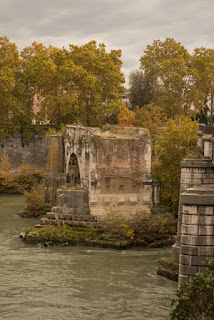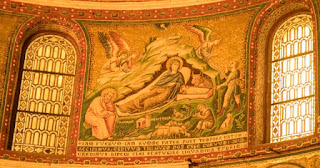Compared to a lot of other days - this was an easy day in Rome. We have a tour of the Colosseum, Palatine Hill and the Forum today. We meet just around the corner from our apartment at the Tour Office at 10:45am. The Colosseum is only a few blocks away. I am using an ear piece with the radio that is a tiny speaker with a tiny cord that fits over the back of your ear. Not in your ear like an ear bud - which always falls out of my ears. Not like headphones that fit tightly over your ears which cause earaches for me - this was perfect. The tour is supposed to be 3 hours which means lunch will be late - sometime after 1:45pm. We first went up to the second level which meant climbing tall,
uneven steps up 3 levels. My entire body complained but I made it.
Inside on the second level.
Looking down into the dungeons. We heard all about the "games" that were shown here. There were at least 5 different schools training gladiators. Each school used a different technique to fight. The techniques ranged from a well protected body with armour and shield, but a short sword to someone with no body armour or shield, but with a large net and a Triton (looks like a 3 tine pitch fork on a long pole). They are actually pretty well matched as they sometimes fight each other, not just those trained in the same way. There were also "hunters" who fought with the animals. Our guide said you could become a gladiator in several different ways. If you were a slave, your master could just tell you that is what you were going to do. If you were a free man, but very poor, you could choose this career, knowing it might last long. Or someone could spring you out of prison and you would actually become a slave to that person. Usually an agreement was made such as - you had to win 15 fights and then he would free you. This was actually a big money maker for the slave owners as there was a lot of betting going on.
The people who worked in the dungeon also had to deal with water danger. They could also flood the bottom section with water and stage water battles with small ships. They stopped doing this after a while as they were running out of slaves who kept drowning.
View from the second level towards Palantine Hill.
In the photo below, the stone on the left is original, the brick on the right is a restoration.
Next, Palatine Hill. Rome has 7 hills, most of the names I have forgotten, but rich people and the rulers build palatial buildings on these hills. All famous rulers built their own palace which would included public areas to accommodate business and personal areas for their families. I did not take many photos as it was not very exciting. But there was one area where they are restoring a fresco floor and another wall that once held a fresco, but it is badly damaged.
Our guide extolling on the beauty that must have been on the wall.
Building huge gates like the Arch de Triumph in Paris is a way to honor an Emperor usually after he has died. All the ones we saw were beautiful.
I don't remember who these gates were memorializing. This is another one.
And another. The third picture down shows a menorah. This is supposedly the first time that the symbol is depicted in Rome. It was after the sacking of Jerusalem and the destruction of Solomon's temple.
And the last Gate.
Views from Palatine Hill of the Forum and in the Forum.
This door and door frame is original. That is because it was made into a church early on and the law was that you could not reuse building material from churches in another building. Even the Colosseum was sanctified by the church so that it could be preserved. I believe the guide said that their is a ceremony once a year in the Colosseum where the Pope, or someone every high up does the stations of the cross. She said she had never been as it is extremely popular and it is very crowded.
So that was my experience in Rome - we went back to the restaurant next to our apartment for a late lunch - the tour actually ended at 2:30 so it was fashionably late. Then home to pack for our trip to Amsterdam tomorrow.
Thursday, November 16, 2017
Wednesday, November 15, 2017
Rome Street Scenes and Things on Walls!
The image a city presents always intregues me. A good idea of a place can be seen by what they put on their walls. I have always loved street scenes - including doors and Europe has so many beautiful doorways. Here in Italy you find a lot of garage doors/ or metal doors closing up small stores that are decorated. These were all taken near or in the Trastevera area of Rome.
A memorial to WWII.
I love the arch of these trees - over the sidewalk and into the river.
A memorial to WWII.
I love the arch of these trees - over the sidewalk and into the river.
Exploring the Trastevere
Today our plan is to explore the area on the other side of the river Tiber. We start out in the usual way by going by the Vittoriana. Then we head to the river and of course see more Roman Ruins. These are from the Republican period.
The Tempio Di Portunus is a little further on. The second picture shows a little detail on the cement in the pillars. By this time they had already discovered the perfect recipe for cement - which helped these buildings survive all these centuries. It did limit how high they could go. Now, the cement is made to be very solid and can support the weight of many, many stories. But it does not last as long.
The weather is holding up so far. The trees along the river Tiber have turned a beautiful fall color.
We found an old city gate called Porta Settimiana from the 3rd century next to some Aurelian Walls. Notice it is now raining. This is supposed to be a much nicer day!
We stopped for some coffee - then, as it is continuing to rain, headed for a museum. This is another family villa type museum. The Farnesina family purchased the villa from another very rich man and continued to decorate it using all the latest, famous artists. Works from Raphael are here.
Doesn't this look like you could just go out into the balcony and look over the city of Rome? The floor is the actual floor we walked on, the rest is a painting.
It is still raining, sigh! Time for lunch. Maybe it will clear up - nope, still raining. So we head for the Piazza Snata Maria in Trastevere. The basilica is located here. We have passed it at least once - but it is totally covered for restoration and we did not recognize it. The Basilic Di Santa Maria in
Trastevere was established in 350 AD. It has had many changes and additions over the years. It is knows for its fabulous mosiacs on the walls in the apse.

The Tempio Di Portunus is a little further on. The second picture shows a little detail on the cement in the pillars. By this time they had already discovered the perfect recipe for cement - which helped these buildings survive all these centuries. It did limit how high they could go. Now, the cement is made to be very solid and can support the weight of many, many stories. But it does not last as long.
The weather is holding up so far. The trees along the river Tiber have turned a beautiful fall color.
We found an old city gate called Porta Settimiana from the 3rd century next to some Aurelian Walls. Notice it is now raining. This is supposed to be a much nicer day!
We stopped for some coffee - then, as it is continuing to rain, headed for a museum. This is another family villa type museum. The Farnesina family purchased the villa from another very rich man and continued to decorate it using all the latest, famous artists. Works from Raphael are here.
Doesn't this look like you could just go out into the balcony and look over the city of Rome? The floor is the actual floor we walked on, the rest is a painting.
It is still raining, sigh! Time for lunch. Maybe it will clear up - nope, still raining. So we head for the Piazza Snata Maria in Trastevere. The basilica is located here. We have passed it at least once - but it is totally covered for restoration and we did not recognize it. The Basilic Di Santa Maria in
Trastevere was established in 350 AD. It has had many changes and additions over the years. It is knows for its fabulous mosiacs on the walls in the apse.

Subscribe to:
Comments (Atom)











































































